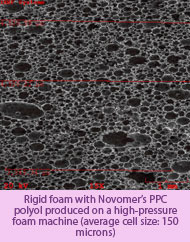
US materials company Novomer has commercialised Converge polypropylene carbonate (PPC) polyols for use in polyurethane formulations targeted at adhesive, coatings, sealants, elastomers, and rigid and flexible foams. The company’s initial product offerings – 1000 and 2000 molecular weight grades – are manufactured at a multi-thousand-tonne commercial-scale toll facility in Houston, Texas.
“This product introduction is a significant milestone in the commercial development of this breakthrough technology,” said Peter Shepard, Chief Business Officer. “Our successful scale-up and product launch validates the robustness of our manufacturing technology and the strong interest we’ve received from a wide range of applications in the polyurethanes market.” The Converge tradename was selected because these polyols represent the unique convergence of Performance, Costs, and Sustainability.
Converge polyols are designed to replace conventional petroleum-based polyether, polyester, and polycarbonate polyols. They are based on the co-polymerisation of carbon dioxide (CO2) and epoxides and the resulting products contain more than 40% by weight CO2. The use of waste CO2 as a significant raw material yields a product with a low carbon footprint. In addition, since waste CO2 is significantly lower in cost than conventional petroleum-based raw materials, Converge polyol manufacturing costs are favourable compared to conventional polyols when produced at full commercial scale.
In terms of performance, Novomer's Converge polyols have a unique polycarbonate backbone, said to increase the strength and durability of polyurethane products. Incorporating these new polyols into existing formulations yields foams with higher tensile and tear strength, and increased load bearing capacity; adhesives and coatings with improved adhesion, cohesive strength, and weatherability; and elastomers with greater tensile and flexural strength.
In addition, the high CO2 content enabled by Novomer's proprietary technology produces polyols with a calorific content (heat of combustion) that is 40% to 50% lower than conventional polyether, polyester, and polycarbonate polyols. This inherent feature is especially important in polyurethane applications that must meet strict flammability requirements.
The new Converge polyols are available globally. So far, the materials have found successful commercial use primarily in CASE (Coatings, Adhesives, Sealants, and Elastomers) applications.
Other companies have also made announcements on similar PPCs with German polymers firm Bayer MaterialScience investing EUR15 million into a new production line that will involve the use of carbon dioxide as a building block for polyols and targeting 5,000 tonnes of the material from 2016 (http://www.plasticsandrubberasia.com/may2014/materials3.html)
Meanwhile, US firms Invista and LanzaTech are also investigating the production of butadiene in a 2-step process from LanzaTech CO2 -derived 2,3-butanediol (2,3 BDO) gas fermentation as a route to biobased butadiene, for Invista’s use in the production of nylon. At that time, it was based on carbon monoxide as a feedstock. (http://www.plasticsandrubberasia.com/may2014/materials1.html)
In China, Tian Guan, which is based in Henan province, is working on a CO2 PPC (PP carbonate) degradable composite, targeted at biodegradable film material. (http://www.plasticsandrubberasia.com/apr2014/leadfeature5.html)
(PRA)


















